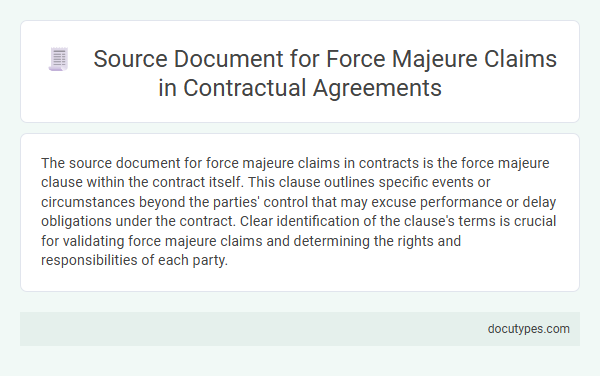The source document for force majeure claims in contracts is the force majeure clause within the contract itself. This clause outlines specific events or circumstances beyond the parties' control that may excuse performance or delay obligations under the contract. Clear identification of the clause's terms is crucial for validating force majeure claims and determining the rights and responsibilities of each party.
Introduction to Source Documents in Force Majeure Claims
Force majeure claims in contracts rely on specific source documents that establish the occurrence of unforeseen events preventing contractual fulfillment. Understanding these documents is essential for validating your claim and ensuring proper legal recognition.
Source documents often include official government notices, natural disaster reports, or expert declarations directly linked to the disruptive event. These documents serve as critical evidence demonstrating the event's impact on contractual obligations. Accurate and timely documentation helps protect your rights and supports a successful force majeure claim.
Importance of Proper Documentation in Force Majeure Events
What is the source document for force majeure claims in contracts? The source document typically is the contract itself, which outlines the force majeure clause detailing applicable events and procedures. Proper documentation is crucial to substantiate claims and ensure compliance with contractual obligations during force majeure events.
Types of Source Documents Accepted in Force Majeure Claims
Source documents for force majeure claims in contracts are critical for validating the occurrence and impact of extraordinary events. These documents serve as evidence to support claims and facilitate contractual relief or adjustments.
- Official Government Decrees - Legal notices or executive orders that declare emergencies or impose restrictions related to natural disasters or pandemics.
- Certified Weather Reports - Meteorological data from recognized agencies documenting extreme weather events such as hurricanes, floods, or earthquakes.
- Third-Party Expert Reports - Assessments by qualified professionals verifying the event's occurrence and its disruption on contractual obligations.
Legal Requirements for Supporting Force Majeure Claims
The source document for force majeure claims in contracts is typically the contract itself, which contains a specific force majeure clause outlining the conditions and procedures for invoking such claims. Legal requirements for supporting force majeure claims demand clear evidence that the unforeseen event directly impacted contractual obligations, making performance impossible or impracticable. Courts often require documentation such as official government declarations, weather reports, or expert statements to substantiate the legitimacy of a force majeure event.
Best Practices for Collecting Source Documents
The source document for force majeure claims in contracts is typically the contract itself, which outlines the conditions under which force majeure can be invoked. This document specifies the events considered beyond control, such as natural disasters or political unrest.
Best practices for collecting source documents include securing original contracts, amendments, and any formal notifications related to the force majeure event. Maintaining clear records and timely communication ensures that your claims are substantiated and compliant with contractual obligations.
Common Pitfalls in Documenting Force Majeure Events
The source document for force majeure claims in contracts is typically the contract itself, specifically the force majeure clause. This clause outlines the conditions under which a party can claim relief due to unforeseen events beyond their control.
Common pitfalls in documenting force majeure events include vague language and failure to specify which events qualify. You must ensure clear definitions and proper notification procedures to avoid disputes and strengthen your claim.
Role of Source Documents in Dispute Resolution
The source document for force majeure claims in contracts is typically the contract itself, which outlines the specific conditions and events considered beyond the parties' control. These documents play a crucial role in dispute resolution by providing clear evidence of the agreed-upon force majeure clauses and the circumstances under which they apply. Courts and arbitrators rely heavily on these source documents to interpret contract terms and determine the validity of force majeure claims.
Verification and Authentication of Force Majeure Documents
The source document for force majeure claims in contracts is crucial for verifying the legitimacy of the event claimed. Proper authentication ensures the claim is valid and enforceable under the contract terms.
- Force Majeure Clause - The contract's force majeure clause outlines eligible events and required documentation to support a claim.
- Official Certificates - Government or third-party issued certificates validate the occurrence of force majeure events like natural disasters or government actions.
- Notification Letters - Formal notifications sent by the affected party serve as evidence to initiate the force majeure claim process and meet contract timelines.
Verification and authentication involve cross-checking these documents against contract terms and external sources to confirm claim accuracy.
Case Studies: Successful Force Majeure Documentation
| Case Study | Source Document | Key Elements | Outcome |
|---|---|---|---|
| Construction Delay Due to Natural Disaster | Official Government Weather Reports and Emergency Declarations | Proof of event date, severity, and government acknowledgment of force majeure event | Claim approved; contract timeline extended without penalties |
| Supply Chain Interruption from Global Pandemic | World Health Organization (WHO) Declarations and Local Health Authority Notices | Verification of pandemic status, travel restrictions, and lockdown mandates | Force majeure claim accepted; contract terms renegotiated favorably |
| Industrial Strike Affecting Delivery Schedule | Union Strike Notices and Official Labor Board Communications | Documented strike period and impact on workforce availability | Claim validated; delivery deadlines adjusted with mutual consent |
| Political Unrest Causing Contractual Non-Performance | International Risk Reports and Government Travel Advisories | Evidence of political unrest, travel bans, and operational shutdowns | Force majeure invoked; contract suspended temporarily without liability |
What Is the Source Document for Force Majeure Claims in Contracts? Infographic

